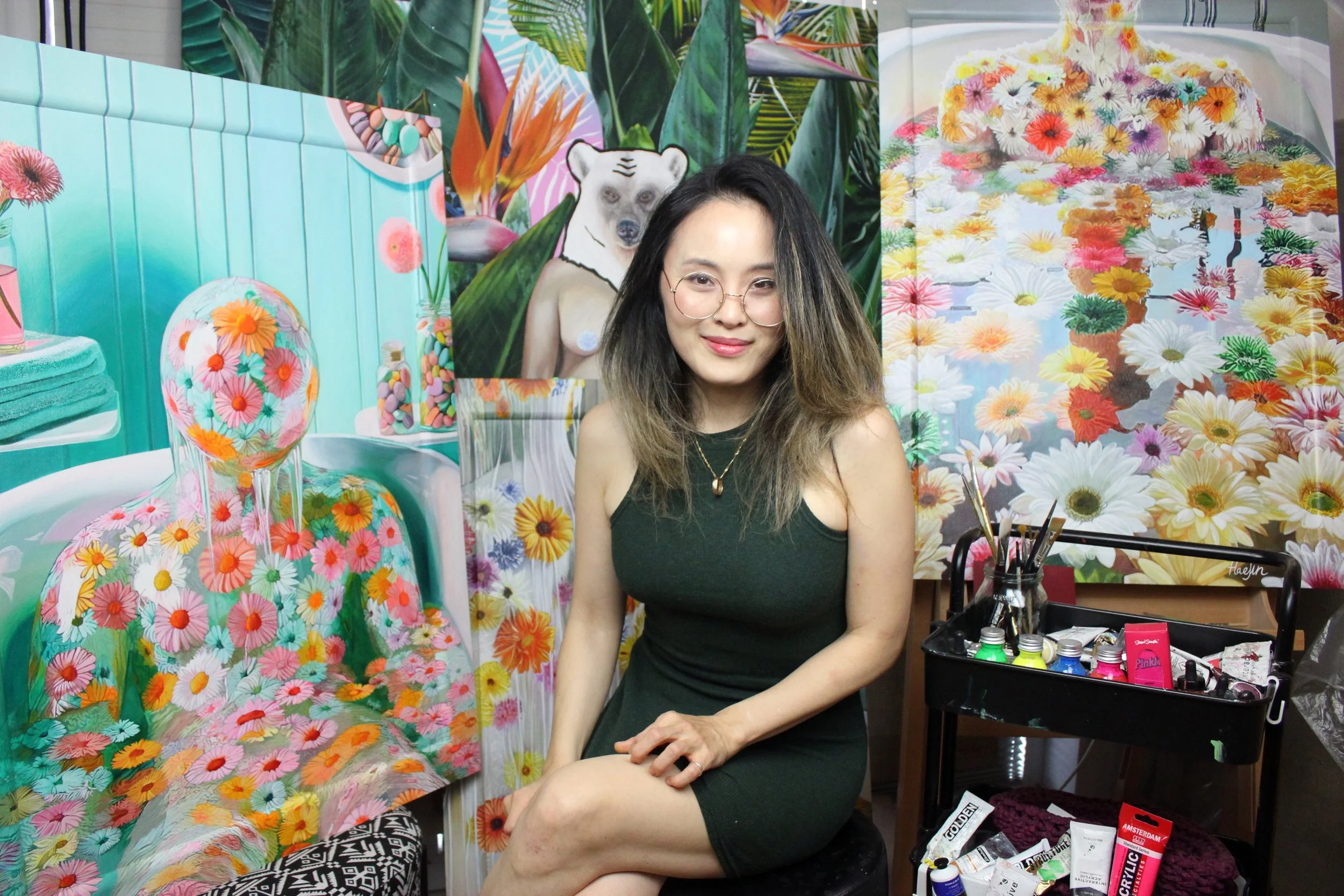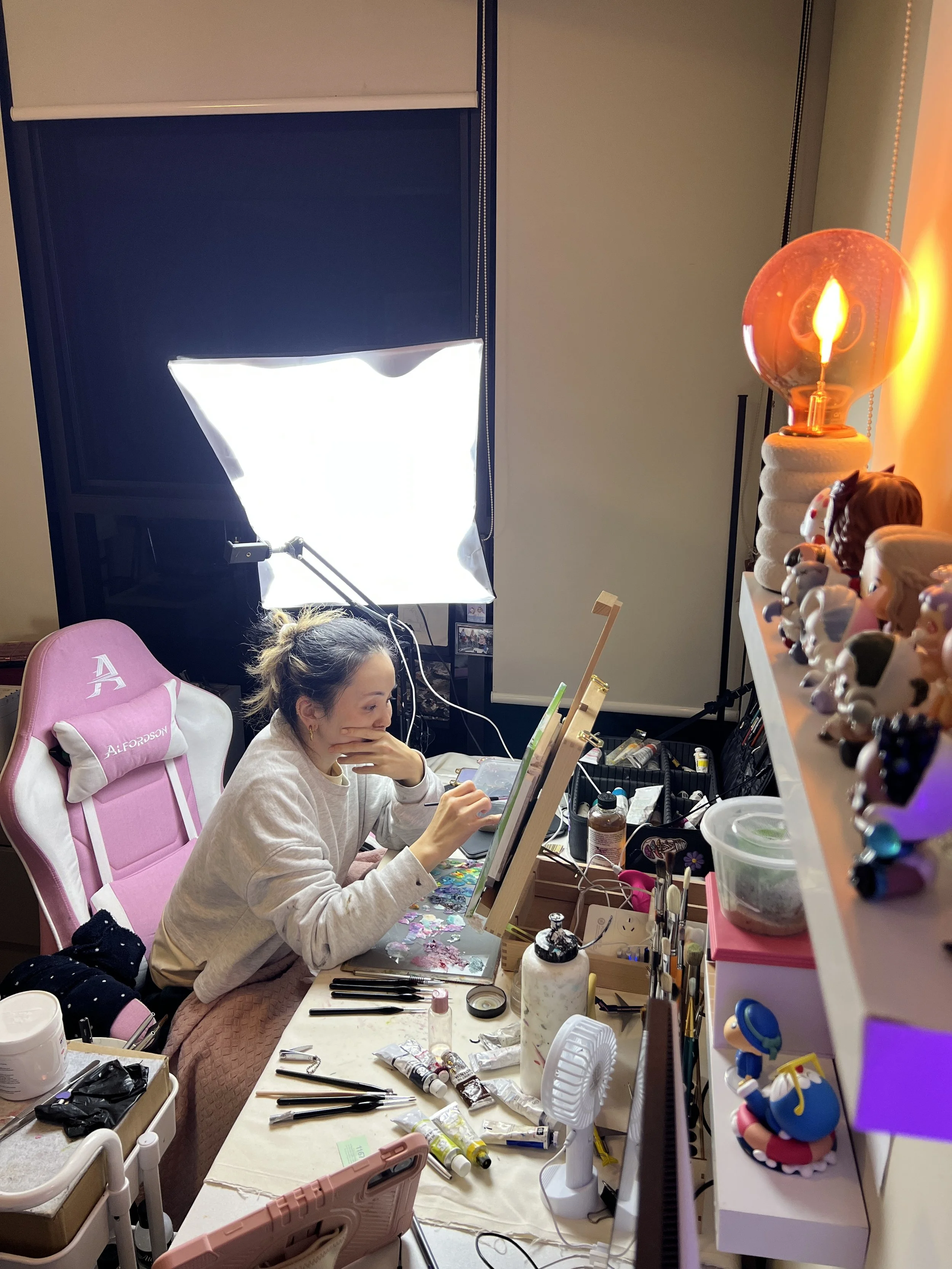Between Worlds with Haejin Yoo
This month, we’re excited to introduce Haejin Yoo, a Korean-born artist who was raised in Australia. Her surreal, symbolic paintings explore identity, introspection, and the fluid nature of the self.
Haejin’s work moves between reality and dream, the conscious and the subconscious. Her paintings often center on women—both familiar and unknowable—situated in intimate spaces like bathrooms or bedrooms. The imagery is rich with symbolism: liquid, veils, reflections, and flowers appear again and again, suggesting transformation, privacy, and the shifting boundaries between one’s inner and outer world.
A self-taught painter, Haejin began creating her own mixed-media works while also exploring carpentry, textiles, and unconventional materials to bring depth and dimension to her pieces. The result is a body of work that feels tactile and emotional, balancing surrealism with grounded human experience. Her work immediately stands out because it pushes the boundary of what people expect. She is brave in her expression and over time has learned to lean into her authenticity.
We first came across Haejin’s work through an online feature, and were immediately drawn to the dreamlike intimacy of her imagery. Her paintings seem to whisper secrets—moments caught between vulnerability and strength. The more you look, the more you begin to see not just a figure, but a mirror.
We later connected through social media and hopped on a call. Even though it was late at night for Haejin, she was still at work in her studio. A testament to her dedication and meticulous attention to detail (some of her artworks took upward of 100 hours to complete!)
In Woman in the Bath VI, part of her ongoing Woman in the Bath series, the bathroom becomes a private stage for introspection. A woman reclines in a bathtub, suspended between light and shadow. The water reflects her image, but imperfectly—hinting at the ways memory, identity, and emotion distort over time. The scene feels calm, but there’s a subtle tension underneath, like the moment right before something shifts.
After the birth of her daughter, Haejin struggled with postpartum depression. She started taking daily baths with her daughter, which quickly became a time of reflection: “a space where the masks I wore as a mother, neighbour, and friend melted away.”
For Haejin, the bathroom is the sanctuary of the home. It’s a place where you are the most exposed and vulnerable version of yourself. In the bath, you become one with the water and you are at peace with your truest self.
Woman in the Bath VIII above, continues on this exploration of the persona. According to Haejin, “the melting flowers in the series symbolize the facades we wear — beautiful yet fleeting, like gerberas, which I’ve always associated with superficiality. The thick goo enveloping the figure represents the layers of these facades. As someone on the spectrum, masking has been a constant part of my life, and this series explores the blurred line between our authentic selves and the personas we present to the world.”
You might not catch it in the picture, but Haejin actually paints along the wooden border of each piece. She creates built-in frames for a more captivating effect. It's such a beautiful touch—like the painting can’t quite be contained by the frame. This subtle detail adds an additional layer of depth and dimensionality.
We love that Haejin’s art invites viewers into a quiet, in-between space where we confront who we are, and who we’re becoming. You see, you feel, and somewhere in the layers of her own story and the subject of the painting, you recognize the shared humanity.
What would you like people to know when they first come across your artworks?
I hope people feel something strange and a little familiar when they see my work, even if they don’t understand it right away. What they probably wouldn’t know at first glance is how many years of failure, self-doubt, and depression led to what I’m doing now. For a long time, I painted things I thought were “safe” – pleasant, expected, marketable. But I felt lost and disconnected from what I was making. It wasn’t until I hit a really low point in my life that I started painting just for me, with no filter.
That’s when the Woman in the Bath series was born. The surreal, slightly uncomfortable style people now recognise came from a place of emotional survival. These paintings are deeply personal, strange snapshots from my brain. There’s humour, sadness, obsession, beauty. I don’t paint to be understood, I paint to express the things I struggle to say in words.
When thinking about where you are in your journey, what are you most excited about and what keeps you inspired for the future?
Right now, I feel like I’ve only just begun. I’m still early in the chapter where things are finally working. Where people are connecting with the work, and where I’m starting to believe in myself a little more. What keeps me going is my family. I work incredibly hard because I want to provide a better life for us, especially for my husband, who has supported me so selflessly through all the tough times. Being able to contribute to our stability through art means everything to me. That’s the practical side of my motivation.
But creatively, I feel most inspired by the strange visuals that pop into my head when I least expect it: shiny things, awkward poses, retro bathrooms, insects, surreal body forms. I get excited thinking about where my style might go next. There’s still so much I want to explore, and I’m learning to take up space, unapologetically.
If you could go to dinner with any artist, who would it be and why?
Kim Jung Gi. Without hesitation. I think he was one of the most extraordinary illustrators the world has ever seen. The way he could draw entire complex scenes straight from imagination, with no underdrawing or plan, it was like watching magic happen in real time. I’ve always admired artists who can access the raw energy of their ideas without hesitation or overthinking, and he did that effortlessly. I’d love to just sit with him and watch him work, or even just hear what was going through his mind when he drew.
How did he train his memory? Did he see stories unfold as he drew? I think I’d probably spend the whole dinner quietly staring in awe, forgetting to eat. His work was full of life, humour, motion– and it always felt deeply human. I wish I’d had the chance to tell him how much his work meant to me.
What is the best piece of advice you've been given?
The best advice I ever received was simple: be yourself. Don’t paint what you think people want, paint what makes you happy. It sounds like a cliché, but it took me years to truly understand what that meant. Early on, I was creating work I thought might sell. Things that were “pretty” or easy to digest. But I felt disconnected from what I was making. The more I tried to please others, the more miserable I became.
Eventually, after a series of personal and professional low points, I made the decision to paint purely for myself. I stopped caring about whether it was too strange or too surreal, I just followed my instincts. That’s when people actually started paying attention. That one piece of advice changed everything. Now, if something makes me laugh, cringe, or feel something in my chest, I know I’m on the right track. The rest follows naturally.
What is one thing you wish you'd be asked in an interview?
I wish more people asked about how autism spectrum disorder influences my art – not in a clinical or performative way, but genuinely. Because it does shape everything. My sensory experiences, my emotional responses, my routines, the way I fixate on certain objects or textures. It’s all connected to the way I paint. For example, I often obsess over shiny surfaces, glossy tiles, patterned wallpaper, or overly decorative bathrooms.
These aren't random motifs, they’re part of how I regulate and express emotion. My work is not a commentary on autism, but it’s created through the lens of it. It also gives me a different relationship to empathy. I can’t handle music while I work because it overwhelms me, but I can sit focused for hours with some kind of TV playing in the background. Painting becomes a form of sensory translation. It’s how I process the world when words fall short. That’s something I wish people asked me about more.
How has your practice evolved over time?
It’s changed completely. When I first started, I painted what I thought would please other people - or at least what wouldn’t make them uncomfortable. I used to hide my weird ideas, thinking they weren’t valid or professional enough. I spent years feeling like a failure, like I was missing something everyone else had figured out. It wasn’t until I finally gave myself permission to paint the odd, surreal images in my head that things began to shift. I embraced what I used to call my “bizarre side” - and ironically, that’s what people began to connect with most. Now, I feel free to lean into my instincts: the awkward poses, shiny skin, strange objects, unnerving expressions. It’s no longer about painting what’s beautiful in a traditional sense, it’s about painting what feels honest and emotionally charged. The more I follow that, the more meaningful my practice becomes. And it’s actually fun now.
What music are you listening to these days?
I don’t actually listen to music when I work. I experience hyper-empathy, so music tends to overwhelm me emotionally - it pulls me in too deeply, and I find it hard to focus. Instead, I always have something playing in the background like a TV show, documentary, or movie. I don’t like working in silence. The ambient noise helps me concentrate and keeps my mind in the right space. It’s almost like having company in the room without the distraction of conversation. One track I do love, though, is Pianissimo by Cristobal Tapia de Veer from The White Lotus. It’s haunting and a little eerie - the kind of atmosphere that pairs well with the surreal scenes I paint. But in general, it’s background dialogue and storylines from films or shows that help me stay focused while I work.
Did you always know you wanted to be an artist? If so, was there a particular moment that gave you the confidence to start sharing your work with the world?
Yes, I’ve always known. From the time I was a little girl, drawing was the one thing I felt completely at home doing. I didn’t always think I could make a career from it, especially during the difficult years when nothing seemed to be working, but I never stopped creating. What really gave me the confidence to start putting my work out there was encouragement, especially from my husband. He’s been my biggest supporter. Even when I was filled with doubt, he reminded me that what I was doing mattered. He saw value in my work before I did. I still remember the moment I sold one of my earlier surreal pieces and someone said, “I’ve never seen anything like this before.” That stuck with me. It reminded me that being different wasn’t something to hide, it was something to embrace. That shift in thinking is what helped me take my art seriously and share it with the world.







